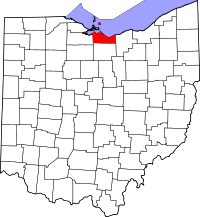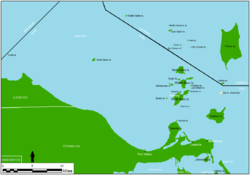Kelleys Island, Ohio
| Kelleys Island, Ohio | |
|---|---|
| Village | |
|
Aerial photo of Kelleys Island, looking west | |
| Nickname(s): Kelleys | |
 Location of Kelleys Island, Ohio | |
|
Location of Kelleys Island in Erie County | |
| Coordinates: 41°36′5″N 82°41′51″W / 41.60139°N 82.69750°WCoordinates: 41°36′5″N 82°41′51″W / 41.60139°N 82.69750°W | |
| Country | United States |
| State | Ohio |
| County | Erie |
| Area[1] | |
| • Total | 4.41 sq mi (11.42 km2) |
| • Land | 4.35 sq mi (11.27 km2) |
| • Water | 0.06 sq mi (0.16 km2) |
| Elevation[2] | 597 ft (182 m) |
| Population (2010)[3] | |
| • Total | 312 |
| • Estimate (2012[4]) | 313 |
| • Density | 71.7/sq mi (27.7/km2) |
| Time zone | Eastern (EST) (UTC-5) |
| • Summer (DST) | EDT (UTC-4) |
| ZIP code | 43438 |
| Area code(s) | 419 |
| FIPS code | 39-39662[5] |
| GNIS feature ID | 1064922[2] |
|
Kelleys Island South Shore District Kelleys Island Historic District | |
| Location |
Water St. on the southern side of Kelleys Island (original) Entire island (increase) |
|---|---|
| Coordinates | 41°35′41″N 82°42′35″W / 41.59472°N 82.70972°W |
| Area |
23 acres (9.3 ha) (original) 2,888 acres (1,169 ha) |
| Architectural style | Italianate, Queen Anne, Gothic Revival |
| NRHP Reference # | 75001380 (original); 88002734 (increase)[6] |
| Added to NRHP |
March 27, 1975 (original) December 15, 1988 |
Kelleys Island is both a village in Erie County, Ohio, United States, and the island which it fully occupies in Lake Erie. Originally known as Island Number 6 and later Cunningham Island, it was renamed in 1840 for brothers Datus and Irad Kelley, who were largely responsible for cultivatating the island's quarrying, logging and winemaking industries.[7]
Originally inhabited by Native Americans, Kelleys Island was used by the US Military as a rendezvous post during The War of 1812. During the early 19th century, several different groups made ill-fated attempts to harvest the island's limestone and lumber resources; none were successful until the Kelley brothers made their attempt in the 1830s. The population was 312 at the 2010 census.
Today, Kelleys Island is primarily a vacation destination, and sees thousands of visitors each summer. Notable attractions include its various beaches, parks, and campgrounds. Several ferries provide regular transport for most travelers; the island also features a number of marinas, as well as a small airfield for private planes. It is the largest of the American Lake Erie Islands, and is a part of the Sandusky, Ohio Metropolitan Statistical Area.
History
Native Americans and Inscription Rock
Kelleys Island is a remnant of a Devonian limestone ridge carved around 10,000 B.C. during the Pleistocene era.[8] The first known inhabitants of Kelleys Island were either Erie, Cat, or Neutral Native Americans who lived in the area dating back to around the 17th century.[9]
On the south shore of the island near what is now downtown, there is a large limestone rock that features pictographs drawn over a number of years by these early settlers.[7][9] White settlers in the mid-19th century named the piece Inscription Rock. The Kelleys Island Historical Society believes that the carvings date to roughly 1643, and that the rock was used by the Native Americans to impart information to one another about how the hunting had been in the area, and where their group would next be traveling to.[9]
Many different items and scenes are cut into the large flat top side of the rock, which measures 32 feet (9.8 m) by 21 feet (10 by 6 m). Over time, the elements have worn down much of what was originally inscribed on the rock. The people inhabiting the island were largely annihilated by the Iroquois around 1665.[7]
Early white settlers
In the late 18th century, the Connecticut Land Company did a geological survey of the Lake Erie area, and named the land mass "Island Number 6".[10]
The first white man known to have lived on the island was a French pioneer known only as "Cunningham".[11][12] He traveled to the island in 1803 with the intention of making his home there, at a time when it was still inhabited by Native Americans.[12] For a while, Cunningham enjoyed friendly relationship with native people: he built a log cabin near their village, socialized with their hunters, and traded goods with them on a regular basis.[12] At some point, Cunningham had a disagreement with the Native Americans, and a group of them tore down his home, stole all his possessions, and attempted to kill him.[12] He escaped to the Ohio Peninsula via canoe, but died shortly afterwards as a result of his wounds.[12] For many years after his death, the island was known as Cunningham Island.[12]
Over the next decade, several other white adventurers attempted to explore the island, all of them eventually being driven away by the native people.[12] During the War of 1812, the west shore of Cunningham Island was made a military rendezvous post by General William Henry Harrison. Shortly after the war ended, the Native Americans finally abandoned the island.[12] In 1818, a man named Killam briefly attempted to start a logging company, but abandoned the island after the large steam-powered boat he used to transport wood to the mainland wrecked and sank.[12] Around 1826, people slowly began settling on the island; by 1830, approximately six families made up its entire population.[12]
Around 1833, a French-Canadian veteran of the War of 1812 named Ben Napier attempted to appropriate Cunningham Island and nearby Put-in-Bay as his own through squatters rights.[13][14] He and his associates terrorized the families living in the area, hijacked their cabins, and killed their livestock.[12][15] Napier was eventually legally ousted after it was realized that he did not legitimately own the land.[12]
Acquisition by the Kelleys
In 1830, John Clemons and his brother began mining the island's limestone, and opened its first quarry.[16] They built a dock its north side in order to ship the rock to the American mainland.[17] Shortly afterwards, brothers Datus and Irad Kelley became aware of the island's potential worth, and slowly began purchasing its land in parcels.[17]
Datus and Irad Kelley were born in Middlefield, Connecticut on April 24, 1788 and October 24, 1791, respectively.[18][19] Datus moved to Rocky River, Ohio in 1811, working as a surveyor and sawmill owner.[19] Irad moved to Cleveland, Ohio in 1812, eventually becoming a successful merchant, postmaster, sailor, and real-estate investor.[18] Irad Kelley first became aware of the island after being forced to seek shelter there while transporting goods via sloop sailboat from Detroit to his shop in Cleveland.[10][20] On August 20, 1833, the two began purchasing parcels of land on Cunningham Island at the rate of $1.50 per acre.[18] They eventually owned the entire 3,000-acre (12 km2) island, and in 1840 changed its name to Kelleys Island.[11][18] By this time, the population had risen to 68 people.[12]
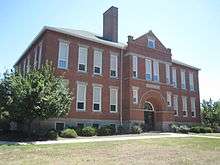
The brothers quickly began improving and expanding the island's docks to export limestone, fruit, and red cedar lumber.[12] Soon, 16 limestone kilns were producing lime. The village's various industries hired a number of immigrants (including young children), many of whom would work on the island during the summer and return to their homeland during the winter.[12] Among the nationalities working on the island at that time were Poles, Slavs, Macedonians, Hungarians, Bulgarians, Italians and Portuguese.[12] Datus Kelley encouraged sobriety, and paid his employees bonuses for abstaining from "intoxifying liquors".[12]
In 1842, Charles Carpenter (son-in-law of Datus Kelley) of Norwich, Connecticut began growing and harvesting grapes for wine on Kelleys Island; by the early 20th century, the island was annually producing 500,000 gallons of wine per year.[12]
The quarries were the origin of the Kelley Island Lime & Transport Company, which was once the largest producer of limestone and lime products in the world, operating between 1896 and the early 1960s. Numerous ruins of these operations and quarries now dot the island.
The small village grew quickly, and soon a library and post office were erected. In 1901, the Estes Schoolhouse was built at a cost of $15,000.[12]
Recent history and modern day
Kelleys Island is heavily forested among several residential areas, some for year-round residents, others for summer vacationers. Some small farms and a small limestone quarrying operation exist on the island. Each Summer since 1974 (typically in August), the island hosts a weekend-long homecoming festival, and includes a theme parade featuring both locals and vacationers, a picnic, and a number of food and craft booths.[21]

Kelleys Island has a cemetery located on Division Street, about a mile north from the center of downtown.[22] Although the cemetery is relatively small, several hundred people are buried or have memorial headstones there.[22] Burials there include that of Datus Kelley, an early developer of the area and one of the island's namesakes.[23]
In 1975, 23 acres (9.3 ha) on the island's southern shore were designated a historic district, the Kelleys Island South Shore District, and added to the National Register of Historic Places. In 1988, the district was renamed to the Kelleys Island Historic District and expanded to include the entire island.[6]a[›]
On August 19, 2010, three downtown businesses on Division Street were destroyed after a fire started in the attic of the Country Store.[24] The fire quickly spread from the convenience store where it began to the businesses that it shared the building complex with, Papa T's Ice Cream Shop and Vi's Island Treasures.[24] The vinyl siding of the neighboring Island House restaurant partially melted during the incident.[25] The Country Store had closed following the summer of 2009, and was vacant at the time of the fire; an Ohio state fire marshal later ruled the blaze had started after a work lamp was left on in the vacant grocery shop's attic.[25][26] The Kelleys Island Volunteer Fire Department of 12 people took approximately 15 minutes to arrive on the scene.[26] 15 to 20 additional firefighters were also dispatched from the mainland.[25] No one was injured during the fire; the entire building was razed shortly afterward.[25]
Attractions

Beaches and wildlife
Kelleys Island features a number of public beaches. Many areas allow swimming, boating, and fishing.
In August 2010, a report from The Nature Conservancy in conjunction with the US Fish and Wildlife Service U.S. Fish & Wildlife Service, the Ontario Ministry of Natural Resources, and several other non-profit agencies listed Kelleys as the 7th most ecologically threatened island in the Great Lakes.[27][28][29] The reasons given for the island's poor ecological health included "development, tourism and recreation, marinas and resorts, increased roads and buildings, incompatible agricultural practices and invasive species."[27][29]
Businesses
The most common types of establishments on Kelleys Island are pubs and restaurants, almost all of which close for the winter season in September and reopen around May. The island also features a coffee shop, miniature golf course, several small general/convenience stores, and a large number of gift shops. No liquor is sold on the island outside of bars or restaurants, but several shops do sell beer and wine.
The island is also home to The Kelley's Island Wine Company, originally one of the largest wineries in the U.S., established in 1872. It stopped operation after two major fires eventually destroyed its facility during prohibition. The ruins of the original winery are still standing on the island. The Zettler family re-established The Kelley's Island Wine in 1982 at the site of one of the oldest stone cottages on the island, known as the Nicholas Smith house (built c. 1865). Kirt and Robby Zettler continue to operate it as a working winery and tourist attraction.
Camps
Camp Patmos, a Christian youth camp, is located on the northeast side of the island. Camp Patmos was purchased in 1952 from Nativity B.V.M. Parish of Cleveland to be the site of a faith-based summer camp for youth. A chapel was built in 1959 and a pool was added in 1968. 20 new cabins were also built for campers. Camp Patmos has added many more buildings and programs since then including a rec center, a 200-foot (61 m) dock, pophouse, guest cabins and continues to run Christian summer camp and retreat programs for youth from 4th thru 12th grade.[30] The Erie County 4H Camp is located on the north side of the island.
Transportation
Ferries
The first ferry to regularly service the island was the Neuman Ferry, founded in 1907 by John Paul Neuman.[31] The boat originally provided transport from Lakeside, Ohio to the island's East Harbor State Park.[31] At their peak, the company contained a fleet of four boats: the Commuter, the Corsair, the Kelleys Islander, usually running out of Marblehead and the Challenger running out of Sandusky.[31] The company folded in the first decade of the 21st century due to financial mismanagement and excessive growth with low market share.
Currently, the Kelleys Island Ferry is the only line that runs year-round (weather permitting) between the island and the mainland. The boat line is owned by James "Jim" Palladino and his family.[32] In the past, Palladino has been tied to the Cleveland Mafia.[33][34] After the Neuman Ferry line closed, Palladino purchased several boats from the company, as well their dock on the island. The private ferry runs to Marblehead, Ohio every half-hour during the tourist season, with the ride lasting approximately 25 minutes.[35]
A competing ferry line named the Jet Express runs many times daily from Sandusky to Kelleys Island.[36] The boat line started in 1988, and only runs during the summer months. It is also a passenger-only ferry, not carrying vehicles.[37] The Jet Express boat takes approximately 20 minutes for the trip from Sandusky.[35]
Airport
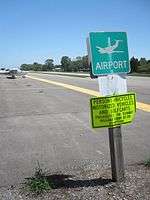
The east side contains a small public airport, called the Kelleys Island Land Field Airport (FAA LID: 89D).[38] It features a terminal building, a single runway, and a parking area for planes.[38][39]
Airline and destination
| Airlines | Destinations |
|---|---|
| Griffing Flying Service | Port Clinton |
Other
Due to its small size, many people use bicycles, golf carts and motor scooters as their regular transportation while on the island.[35] Automobiles can be transported to the island via ferry; though most roads are modern, some streets on the north side as well as near the quarries are unpaved.
Geography

Kelleys Island is located at 41°36′5″N 82°41′51″W / 41.60139°N 82.69750°W (41.601343, -82.697442).[40]
According to the United States Census Bureau, the village has a total area of 4.41 square miles (11.42 km2), of which 4.35 square miles (11.27 km2) is land and 0.06 square miles (0.16 km2) is water.[1]
Geology
The bedrock of Kelleys Island is the Devonian Columbus Limestone, a fossiliferous formation that is quarried on the island for building stone and other uses.
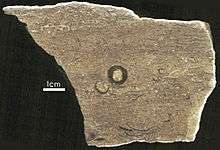
On the northern side, Kelleys Island State Park offers camping and protects the Glacial Grooves State Memorial and the North Shore Alvar State Nature Preserve. The glacial striations puts Kelleys in mild fame as inside are the largest and most easily accessible remains of glacial grooves in the world.
Demographics
| Historical population | |||
|---|---|---|---|
| Census | Pop. | %± | |
| 1900 | 1,174 | — | |
| 1910 | 1,017 | −13.4% | |
| 1920 | 708 | −30.4% | |
| 1930 | 638 | −9.9% | |
| 1940 | 564 | −11.6% | |
| 1950 | 324 | −42.6% | |
| 1960 | 171 | −47.2% | |
| 1970 | 175 | 2.3% | |
| 1980 | 121 | −30.9% | |
| 1990 | 172 | 42.1% | |
| 2000 | 367 | 113.4% | |
| 2010 | 312 | −15.0% | |
| Est. 2015 | 312 | [41] | 0.0% |
2010 census
As of the census[3] of 2010, there were 312 people, 175 households, and 99 families residing in the village. The population density was 71.7 inhabitants per square mile (27.7/km2). There were 859 housing units at an average density of 197.5 per square mile (76.3/km2). The racial makeup of the village was 98.1% White, 0.3% African American, 0.6% Asian, 0.6% from other races, and 0.3% from two or more races. Hispanic or Latino of any race were 1.3% of the population.
There were 175 households of which 10.9% had children under the age of 18 living with them, 52.6% were married couples living together, 1.7% had a female householder with no husband present, 2.3% had a male householder with no wife present, and 43.4% were non-families. 41.1% of all households were made up of individuals and 19.4% had someone living alone who was 65 years of age or older. The average household size was 1.78 and the average family size was 2.34.
The median age in the village was 58.8 years. 9.6% of residents were under the age of 18; 1.3% were between the ages of 18 and 24; 11.2% were from 25 to 44; 43.6% were from 45 to 64; and 34.3% were 65 years of age or older. The gender makeup of the village was 52.6% male and 47.4% female.
2000 census
| Largest ancestries (2000) | Percent |
|---|---|
| German | 28.0% |
| English | 15.9% |
| Irish | 15.3% |
| Polish | 8.9% |
| Italian | 6.1% |
As of the census[5] of 2000, there were 367 people, 183 households, and 112 families residing in the village. The population density was 80.5 people per square mile (31.1/km²). There were 709 housing units at an average density of 155.5 per square mile (60.0/km²). The racial makeup of the village was 99.46% White, 0.27% African American, 0.27% from other races. Hispanic or Latino of any race were 0.27% of the population.
There were 183 households out of which 15.8% had children under the age of 18 living with them, 53.6% were married couples living together, 5.5% had a female householder with no husband present, and 38.3% were non-families. 35.5% of all households were made up of individuals and 15.3% had someone living alone who was 65 years of age or older. The average household size was 1.99 and the average family size was 2.55.
In the village the population was spread out with 15.0% under the age of 18, 2.2% from 18 to 24, 19.9% from 25 to 44, 40.1% from 45 to 64, and 22.9% who were 65 years of age or older. The median age was 52 years. For every 100 females there were 100.5 males. For every 100 females age 18 and over, there were 102.6 males.
The median income for a household in the village was $35,500, and the median income for a family was $49,375. Males had a median income of $29,643 versus $26,071 for females. The per capita income for the village was $21,944. About 7.6% of families and 9.8% of the population were below the poverty line, including none of those under age 18 and 14.0% of those age 65 or over.
Education
Kelleys Island School serves the island and is located on Division Street.[43]
See also
Notes
^ a: The actual area of the expanded district is 2,888 acres (1,169 ha),[6] which is mathematically equivalent to the island's area 4.6 square miles.
References
- 1 2 "US Gazetteer files 2010". United States Census Bureau. Retrieved 2013-01-06.
- 1 2 "US Board on Geographic Names". United States Geological Survey. 2007-10-25. Retrieved 2008-01-31.
- 1 2 "American FactFinder". United States Census Bureau. Retrieved 2013-01-06.
- ↑ "Population Estimates". United States Census Bureau. Retrieved 2013-06-17.
- 1 2 "American FactFinder". United States Census Bureau. Retrieved 2008-01-31.
- 1 2 3 National Park Service (2009-03-13). "National Register Information System". National Register of Historic Places. National Park Service.
- 1 2 3 Kelleys Island Chamber of Commerce page: "Island history".
- ↑ Kelleys Island Nature article: "About Kelleys Island".
- 1 2 3 Kelleys Island Historical Society page for Inscription Rock.
- 1 2 Touring Ohio page: "Kelleys Island".
- 1 2 Lakewood, Ohio Public Library page: "Local History Files: 7: Biography K-L".
- 1 2 3 4 5 6 7 8 9 10 11 12 13 14 15 16 17 18 19 Lake Erie Islands: Sketches & Stories of the First Century After the Battle of Lake Erie by Michael Gora - pages 108 - 125.
- ↑ Archive.org article: "Full text of "Sketches and stories of the Lake Erie islands" ".
- ↑ Concerning the Van Bunschoten Or Van Benschoten Family in America by William Henry Van Benschoten - page 266.
- ↑ The Plain Dealer article: "The outlaw of Kelleys Island".
- ↑ THE STEAMER ADVENTURE and the KELLEYS ISLAND, OHIO LIMESTONE INDUSTRY.
- 1 2 The Rutherford B. Hayes Presidential Center article: "Paper Trail - No. 9 SEPTEMBER 2004 - QUARRYING ON KELLEYS ISLAND".
- 1 2 3 4 Kelleys Island Historical Society article: "Irad Kelley".
- 1 2 Kelleys Island Historical Society article: "Datus Kelley".
- ↑ Ohio: A History: page 79 at Google Books.
- ↑ Port Clinton Herald article: "Sports take spotlight at Kelleys Island homecoming."
- 1 2 USGenWeb Archives Special Projects: Kelleys Island cemetery information.
- ↑ Kelleys Island Historical Society page for Datus Kelley.
- 1 2 Morning Journal article: "Fire ravages 3 Kelleys Island buildings."
- 1 2 3 4 Mansfield Journal article: "Two businesses destroyed in Kelleys Island fire."
- 1 2 WJW Fox 8 News article: "Kelleys Island Fire Ruled Accidental."
- 1 2 The Plain Dealer article: "Kelleys Island ranked among most ecologically threatened Great Lakes island ecosystems."
- ↑ Toledo Blade article: "Report: Region's islands precious but threatened."
- 1 2 ConserveOnline page: "Islands of Life: A Biodiversity and Conservation Atlas of the Great Lakes Islands".
- ↑ Kelleys Island Historical Association Home Tour Guidebook
- 1 2 3 Neuman Ferry website: "History."
- ↑ Kellys Life newsletter article: "Circus is coming again! Kelly Miller Circus to appear on Kelleys Aug. 9 & 10".
- ↑ Cleveland Scene article: "The Mafia Plot To Kill Dennis Kucinich - A Former Cleveland Police Chief Finally Tells The Whole Story".
- ↑ ClevelandMob.com article: "War of Waste".
- 1 2 3 Kelleys Island Chamber of Commerce page: "Kelleys Island FAQ."
- ↑ jet-express.com page: "Purple Schedule."
- ↑ jet-express.com page: "About Jet Express".
- ↑ kelleysisland.us page: "Airport".
- ↑ "US Gazetteer files: 2010, 2000, and 1990". United States Census Bureau. 2011-02-12. Retrieved 2011-04-23.
- ↑ "Annual Estimates of the Resident Population for Incorporated Places: April 1, 2010 to July 1, 2015". Retrieved July 2, 2016.
- ↑ "Census of Population and Housing". Census.gov. Retrieved June 4, 2015.
- ↑ "Kelleys Island School". Retrieved 2006-12-31.
External links
| Wikimedia Commons has media related to Kelleys Island, Ohio. |
| Wikivoyage has a travel guide for Kelleys_Island. |
- Kelleys Island Chamber of Commerce
- Kelleys Island Historical Society
- Kelleys Island at TripAdvisor
- Kelleys Island Land Field Airport at AirNav

